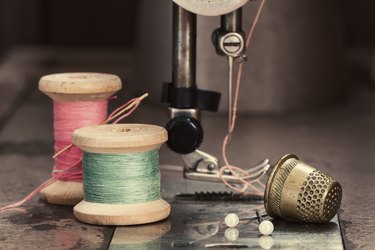Learning to sew can be a challenging process, but sewing is a wonderful skill to have. With the aid of a sewing machine, you can quickly and easily mend clothing, make crafts and create gifts for a low cost. Getting to know your sewing machine and learning the basics, such as threading the machine, is an important first step.

Video of the Day
How to Fill a Bobbin
Though threading a sewing machine varies slightly amongst brands and models, the steps required are usually similar. For specific instructions, refer to the manual that came with your machine.
Video of the Day
The first step in threading your sewing machine is filling your bobbin, the small spool that sits beneath your presser foot. You will need to take care of this before threading the top of the machine, as most sewing machines use the spool pin for bobbin threading as well as for sewing.
To get started, place your thread on the spool pin. If you have a spool cap, use it to hold the thread in place. The thread should be pointed towards the back of the sewing machine.
Pull your thread through the bobbin thread guide. In many cases, the path for bobbin threading is drawn right on your sewing machine, which can be helpful for this step. Place your bobbin on the bobbin winder, and feed the thread through the hole of the bobbin to keep it in place.
Hold on to the end of the thread so it does not slip back through the bobbin hole. Push the bobbin winder against the stopper, a round wheel typically located to the right of the bobbin winder. Push down on the foot pedal, and the bobbin should begin to turn. Thread from the spool pin should start to move onto the bobbin. If this does not occur, refer to your machine's manual for help.
The harder you push on your foot pedal, the more quickly the thread will spool onto the bobbin. If you go too quickly, it can cause the thread to wrap over the top of the bobbin, so take care as you get near its capacity. Most machines will stop and click the bobbin away from the stopper when the bobbin is full.
How to Thread Your Sewing Machine
To thread your sewing machine, start by placing a spool of thread on your spool pin, the upright cylinder usually located at the top right of the machine.
Pull a bit of thread to the guide located to the left of the spool pin. Oftentimes, this guide looks like a metal disc. Wrap the thread under and around the disc, which functions as a thread guide. Usually, this path is marked on sewing machines to help you find your way.
Next, feed your thread down the narrow slit directly beneath the metal disc thread guide. Once you reach the bottom of this trench, wrap the thread to the left and pull it back up the parallel groove. At the top of this second groove is where the take-up lever sits. Use the hand wheel on the side of your machine (rather than the pedal) to move the lever until you are able to feed your thread through it.
Now bring your thread back down the groove containing the take-up lever to the needle area. Feed the thread through the take-up guides just above the needle, which look like sideways hooks. Then, feed the thread through the eye of the needle itself. You may need to use the hand wheel to move the needle up from beneath the presser foot to complete this step. Additionally, if you have difficulty threading the needle, try moistening the end of your thread.
Next, remove the bobbin cover plate located underneath your presser foot so that you can insert your bobbin. Place the bobbin into the circular depression with the thread pointing counterclockwise. Draw the thread to the left until it slips through two notches. Once this has occurred, you should be able to pull the thread without releasing the bobbin.
Hold the bobbin thread and use the hand wheel to move the needle. This will make the needle catch on the bobbin thread. You should now have two strands of thread; one from the spool pin and one from the bobbin, loosely connected with a loop that is formed by the sewing machine. Replace the bobbin cover plate and use the hand wheel to start the needle as you lightly ease-in to use of the foot pedal. You're ready to begin sewing!